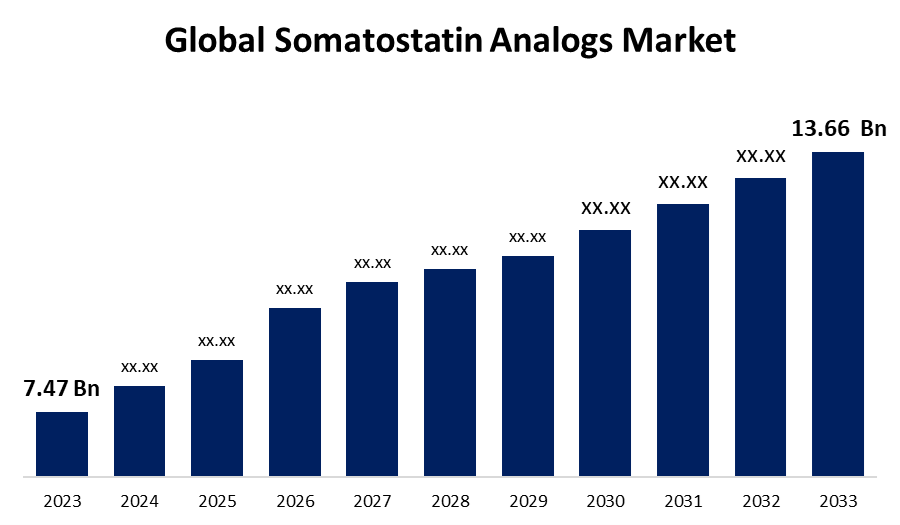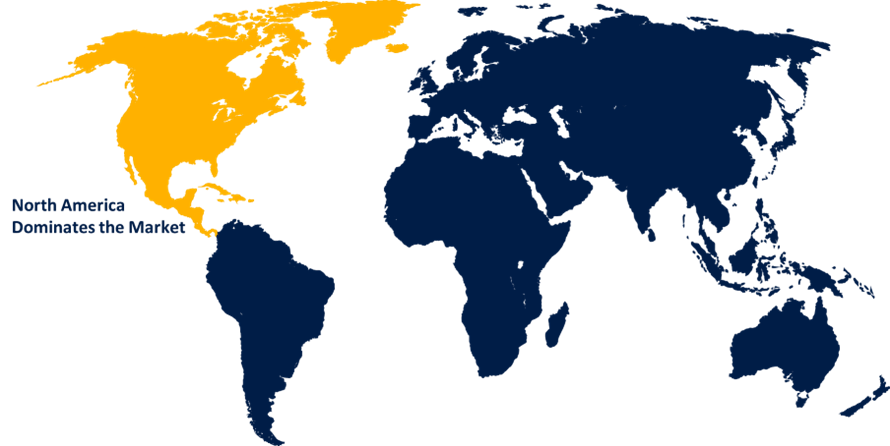Global Somatostatin Analogs Market Size, Share, and COVID-19 Impact Analysis, By Type (Lanreotide, Pasireotide, and Octreotide), By Application (Neuroendocrine Tumors, Acromegaly, and Others), and By Region (North America, Europe, Asia-Pacific, Latin America, Middle East, and Africa), Analysis and Forecast 2023 - 2033.
Industry: HealthcareGlobal Somatostatin Analogs Market Insights Forecasts to 2033
- The Global Somatostatin Analogs Market Size was Estimated at USD 7.47 Billion in 2023
- The Market Size is Expected to Grow at a CAGR of around 6.22% from 2023 to 2033
- The Worldwide Somatostatin Analogs Market Size is Expected to reach USD 13.66 Billion by 2033
- Asia Pacific is predicted to Grow at the fastest CAGR throughout the projection period

Get more details on this report -
The Global Somatostatin Analogs Market Size is predicted to exceed USD 13.66 billion by 2033, Growing at a CAGR of 6.22% from 2023 to 2033.
Market Overview
The global somatostatin analogs market involves the development, production, and commercialization of the somatostatin analogs that are used in the management of the somatotropinomas, thyrotrophinomas, acromegaly, and other abnormal medical conditions. Somatostatin (SST) is a cyclic polypeptide that arises from the processing of a precursor protein into several peptide hormones, such as SST-14, SST-28, and neuronostatin. SST plays a significant role in suppressing the secretion of both endocrine and exocrine hormones in humans. Native SST is characterized by a brief half-life of 1-3 minutes and is quickly broken down by peptidases found in plasma and tissues. After characterization, synthetic analogs (SSAs) with extended half-lives have been created. STT inhibits the secretion of growth hormone, prolactin, thyrotropin, cholecystokinin, gastric inhibitory peptide, gastrin, motilin, neurotensin, secretin, glucagon, insulin, and pancreatic polypeptide. It also inhibits the exocrine secretion of amylase, hydrochloric acid, pepsinogen, an intrinsic factor of gastrointestinal mucosa, and enzymes and bicarbonate of pancreas and bile in the liver. Somatostatin analogues are medicines that stop the body from making too many hormones. Some neuroendocrine tumors (NETs) make large amounts of hormones, causing symptoms. Somatostatin analogues can reduce and control high hormone levels, help with symptoms caused by high hormone levels, slow down and control cancer growth, and potentially shrink the tumor size. The marketed products of somatostatin analogs are octreotide, lanreotide, pasireotide, etc. The increasing prevalence of acromegaly escalates the need for somatostatin drugs, which fuels the market expansion. For instance, Acromegaly is a rare chronic disease caused by a sporadic, GH-secreting pituitary adenoma, with a worldwide prevalence of 30-60 cases per million and an incidence of 2-3 cases per million per year. Less than 5% of cases occur in syndromic or hereditary contexts.
Report Coverage
This research report categorizes the global somatostatin analogs market based on various segments and regions, forecasts revenue growth, and analyzes trends in each submarket. The report analyzes the key growth drivers, opportunities, and challenges influencing the global somatostatin analogs market. Recent market developments and competitive strategies such as expansion, product launch, and development, partnership, merger, and acquisition have been included to draw the competitive landscape in the market. The report strategically identifies and profiles key market players, analyzing their core competencies in each sub-segment of the global somatostatin analogs market.
Global Somatostatin Analogs Market Report Coverage
| Report Coverage | Details |
|---|---|
| Base Year: | 2023 |
| Market Size in 2023: | USD 7.47 Billion |
| Forecast Period: | 2023 - 2033 |
| Forecast Period CAGR 2023 - 2033 : | 6.22% |
| 2033 Value Projection: | USD 13.66 Billion |
| Historical Data for: | 2019 - 2022 |
| No. of Pages: | 280 |
| Tables, Charts & Figures: | 100 |
| Segments covered: | By Type, By Application and By Region |
| Companies covered:: | Midatech Pharma PLC, Chiasma Inc., Peptron Inc., Pfizer Inc., Ipsen Pharma, Sun Pharmaceutical Industries Ltd., Novartis AG, GlyTech, Teva Pharmaceuticals, Debiopharm, Camurus, Crinetics Pharmaceuticals, and Others |
| Pitfalls & Challenges: | COVID-19 Empact, Challenges, Future, Growth, & Analysis |
Get more details on this report -
Driving Factors:
The market for somatostatin analogs is influenced by various crucial driving forces, such as the increasing occurrence of conditions like neuroendocrine tumors, the broadening of therapeutic uses, improvements in drug delivery methods, governmental backing, regional factors, and research and development efforts. Additional incentives for the somatostatin analogs market encompass developing markets, advances in technology, an aging demographic, alliances and partnerships, supportive regulatory frameworks, and approaches centered around patients. The worldwide population is growing older, which is increasing the occurrence of hormonal disorders linked to age. In response, drug manufacturers are entering into partnerships aimed at improving the research, development, and distribution of these analogs. Ultimately, the development of favorable regulatory landscapes and expedited drug approvals are accelerating market growth. As the emphasis on enhancing patient outcomes and quality of life increases, so does the innovation in treatment options.
Restraining Factors
The somatostatin analogs market faces challenges such as high costs, side effects, limited awareness, competition from alternatives, regulatory challenges, and the short half-life of native somatostatin. These factors make them less accessible, especially in low-income regions, and may deter patients from using these treatments.
Market Segmentation
The global somatostatin analogs market share is classified into type and application.
- The octreotide segment dominated the global somatostatin analogs market in 2023 and is anticipated to grow at a significant CAGR throughout the forecast period.
Based on the type, the global somatostatin analogs market is categorized into lanreotide, pasireotide, and octreotide. Among these, the octreotide segment dominated the global somatostatin analogs market in 2023 and is anticipated to grow at a significant CAGR throughout the forecast period. The segmental expansion is attributed to the prolonged therapeutic effect, extensive usage in the management of the acromegaly and thryotrophinomas, relives the symptoms associated with tumor of the gastrointestinal tract, and minimizes the watery diarrhea caused by certain type of cancers.
- The acromegaly segment accounted for the largest share in 2023 and is expected to grow at a significant CAGR throughout the projected timeframe.
Based on the application, the global somatostatin analogs market is categorized into neuroendocrine tumors, acromegaly, and others. Among these, the acromegaly segment accounted for the largest share in 2023 and is expected to grow at a significant CAGR throughout the projected timeframe. The sector growth is attributed to the rising prevalence of acromegaly, tumors in the pituitary adenoma, and excessive production of the growth hormone.
Regional Segment Analysis of the Global Somatostatin Analogs Market
- North America (U.S., Canada, Mexico)
- Europe (Germany, France, U.K., Italy, Spain, Rest of Europe)
- Asia-Pacific (China, Japan, India, Rest of APAC)
- South America (Brazil and the Rest of South America)
- The Middle East and Africa (UAE, South Africa, Rest of MEA)
North America is anticipated to hold the largest share of the global somatostatin analogs market over the predicted timeframe.

Get more details on this report -
North America is anticipated to hold the largest share of the global somatostatin analogs market over the predicted timeframe. Numerous factors, such as the high prevalence of target conditions like neuroendocrine tumors and acromegaly, sophisticated healthcare infrastructure, creative drug delivery systems, robust R&D investments, supportive policies, and high patient and healthcare professional awareness, are driving the North American market for somatostatin analogs. Expanding therapeutic applications for diseases like gastrointestinal disorders and carcinoid syndrome, a robust pharmaceutical industry, high healthcare costs, patient-centric innovations, and cooperative research projects are further factors driving the market. Better access to cutting-edge therapies is made possible by the region's healthcare spending, and demand is being driven by the emphasis on individualized therapy and creative medication delivery methods. Favorable regulations like insurance coverage and government funding for rare disease treatments help drive the market.
Asia Pacific is anticipated to grow at the fastest CAGR throughout the projected timeframe. The market for somatostatin analogs in the Asia-Pacific region is expanding as a result of growing healthcare expenditures, rising target condition prevalence, growing patient and healthcare professional awareness, new markets, government programs, and technology developments. Since they provide cutting-edge therapies at more affordable prices, nations like Thailand and India are emerging as medical tourism hotspots. More individuals can purchase sophisticated medical procedures owing to the middle class's growing disposable income. Somatostatin analogs are becoming more widely available as governments and healthcare institutions concentrate on rare disorders. These therapies are becoming more affordable due to local manufacturing, and the market is expanding as a result of the aging population.
Competitive Analysis:
The report offers the appropriate analysis of the key organizations/companies involved within the global somatostatin analogs market, along with a comparative evaluation primarily based on their product offering, business overviews, geographic presence, enterprise strategies, segment market share, and SWOT analysis. The report also provides an elaborative analysis focusing on the current news and developments of the companies, which includes product development, innovations, joint ventures, partnerships, mergers & acquisitions, strategic alliances, and others. This allows for the evaluation of the overall competition within the market.
List of Key Companies
- Midatech Pharma PLC
- Chiasma Inc.
- Peptron Inc.
- Pfizer Inc.
- Ipsen Pharma
- Sun Pharmaceutical Industries Ltd.
- Novartis AG
- GlyTech
- Teva Pharmaceuticals
- Debiopharm
- Camurus
- Crinetics Pharmaceuticals
- Others
Key Target Audience
- Market Players
- Investors
- End-users
- Government Authorities
- Consulting and Research Firm
- Venture capitalists
- Value-Added Resellers (VARs)
Recent Developments
- In February 2025, Ariceum Therapeutics received the grant of Orphan Drug Designation (ODD) to AC-satoreotide by the U.S Food and Drug Administration. AC-satoreotide is a next-generation somatostatin receptor 2(SSTR2) inhibitor, for the treatment of small lung cell lung cancer (SCLC) and Merkel cell carcinoma (MCC).
- In October 2024, Teva Pharmaceuticals launched the first and only generic version of Sandostatin®1 LAR Depot in the US. This medication is used to treat acromegaly and severe diarrhea for carcinoid syndrome. Octreotide acetate for injectable suspension is a prescription medication used in patients whose initial treatment with octreotide acetate injection has been effective.
Market Segment
This study forecasts revenue at global, regional, and country levels from 2023 to 2033. Spherical Insights has segmented the global somatostatin analogs market based on the below-mentioned segments:
Global Somatostatin Analogs Market, By Type
- Lanreotide
- Pasireotide
- Octreotide
Global Somatostatin Analogs Market, By Application
- Neuroendocrine Tumors
- Acromegaly
- Others
Global Somatostatin Analogs Market, By Region
- North America
- US
- Canada
- Mexico
- Europe
- Germany
- UK
- France
- Italy
- Spain
- Russia
- Rest of Europe
- Asia Pacific
- China
- Japan
- India
- South Korea
- Australia
- Rest of Asia Pacific
- South America
- Brazil
- Argentina
- Rest of South America
- Middle East & Africa
- UAE
- Saudi Arabia
- Qatar
- South Africa
- Rest of the Middle East & Africa
Frequently Asked Questions (FAQ)
-
1. What is the CAGR of the global somatostatin analogs market?The global somatostatin analogs market is projected to expand at a CAGR of 6.22% during the forecast period.
-
2. Who are the top key players in the global somatostatin analogs market?The key players in the global somatostatin analogs market are Midatech Pharma PLC, Chiasma Inc., Peptron Inc., Pfizer Inc., Ipsen Pharma, Sun Pharmaceutical Industries Ltd., Novartis AG, GlyTech, Teva Pharmaceuticals, Debiopharm, Camurus, Crinetics Pharmaceuticals, and others.
-
3. Which region holds the largest share of the market?North America is anticipated to hold the largest share of the global somatostatin analogs market over the predicted timeframe.
Need help to buy this report?